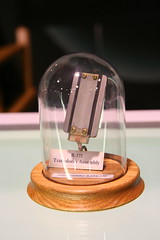 Royer Labs R-121
Royer Labs R-121
Bidirectional Ribbon Microphone
The Royer R-121 is a passive ribbon microphone with an innovative offset ribbon placement that gives the two sides of the microphone distinct features and sound.
 The ribbon element is made of pure aluminum and is 2.5 microns thick, and is tuned to about 40Hz. It is offset toward the front side of the microphone case, which among other features provides a high-SPL capability of 135 dB on the front side. The rear side is equally sensitive but brighter (and less able to handle high SPL). Royer bills this feature as “two mics in one.” This innovation was patented in 1999.
The ribbon element is made of pure aluminum and is 2.5 microns thick, and is tuned to about 40Hz. It is offset toward the front side of the microphone case, which among other features provides a high-SPL capability of 135 dB on the front side. The rear side is equally sensitive but brighter (and less able to handle high SPL). Royer bills this feature as “two mics in one.” This innovation was patented in 1999.
The ribbon is 1.75 inches long, by 3/16ths (4.7mm) wide. The magnets, which define the active area of the ribbon, are 1.5 inches long.
Royer Labs promotes the following features of the microphone:
- High SPL Capabilities
- No internal active electronics to overload or produce distortion up to maximum SPL rating
- Extremely low residual noise
- Ribbon element is not affected by heat or humidity
- Absence of high frequency phase distortion
- Equal sensitivity from front or back of element
- Consistent frequency response regardless of distance
That Royer offers a lifetime warranty (to the original owner) for this mic is a testament to its build quality. The ribbon element was originally warrantied for 1 year; more recently, the company changed its policy to “first re-ribbon free.”
The mic is available in “Burnished Satin Nickel” or “Matte Black Chrome” finishes, and ships in a wood case. Matched pairs are available.
In 2008, Royer Labs began shipping a “Live” version of the R-121, called the R-121L. It is distinguished by a thicker, more durable ribbon (4 microns thick) and a red logo badge. It is intended for higher-SPL live applications.
 Note that the design of the mic, in which parts of the ribbon housing extend beyond the diameter of the body (giving the mic its characteristic “ears”), appears to be based on an early ribbon mic design by Bang & Olufsen, the Beomic BM3 (designed in 1955).
Note that the design of the mic, in which parts of the ribbon housing extend beyond the diameter of the body (giving the mic its characteristic “ears”), appears to be based on an early ribbon mic design by Bang & Olufsen, the Beomic BM3 (designed in 1955).
SoundOnSound
The Royer was lovely on acoustic: intensely clear, yet full. Using the front side, it almost made the guitar sound like a Fender Strat by pulling up the body so much. It was eminently useable, and a very nice contrast to the Oktava [MK-012] which, by comparison, offered all detail and no body. The reverse side of the mic, on the other hand, resulted in a tightly-controlled, brighter version of the same character, which we felt should sit fantastically in a pop mix.
The Royer Labs R-121 is also known as: 121, R121, R-121L.
The mic was released in 1998.
Specifications
| Pickup Patterns | Pads & Filters |
|---|---|
|
Bidirectional
(3.16 mV/Pa; 30 - 15,000 Hz) |
|
| Ribbon Construction | Impedance | SPL/Noise |
|---|---|---|
| 2.5-micron, 3/16''x1.75'' offset aluminum ribbon | 300 Ohms (Low) | Max SPL: 135 dB |
| Weight | Length | Max Diameter | Interface(s) |
|---|---|---|---|
| 244g (8.61oz) | 158mm (6.22'') | 25mm (0.98'') |
|
| Power Specifications |
|---|
Did we get anything wrong on this page? Please let us know!







